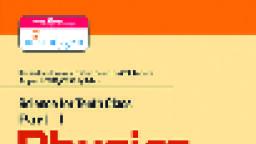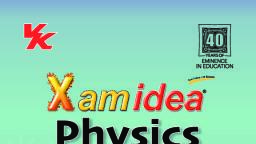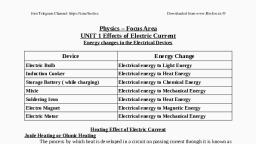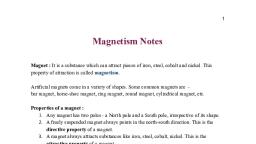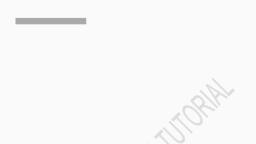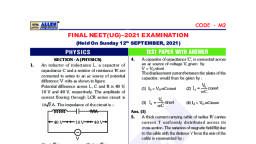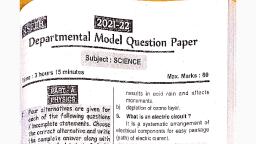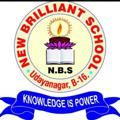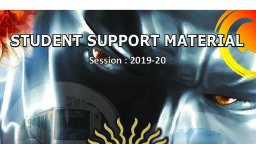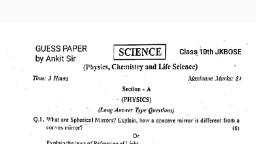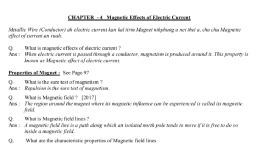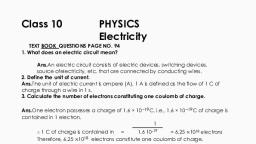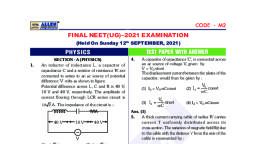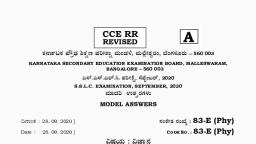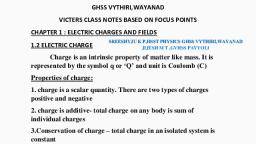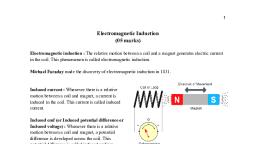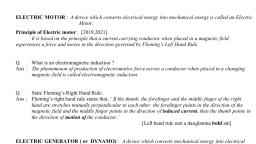Page 1 :
ELECTRICITY, 1. Define one coulomb of charge? 1m, Ans; One culomb is the amount of charge carried by one ampere current flowing for one second., 2. Define an ampere of current. Im, Ans: The flow of one culomb of charge in one second is known as an ampere of current., 3. Define one volt. im, Ans: One volt is the electric potential between two points of conducting wire when one joule of work, is done in moving IC charge from one point to other., 4. Why is a battery or cell always connected in a circuit? 1m, Ans: It supplies electrical power converting chemical energy into electrical energy., 5. What makes electric charge flow? 1m, Ans: Electric charges flow if there is difference in electric pressure in the ends of the conducting wire., 6. Give reason for nitrogen and argon gases filled in the electric bulb. 1m, Ans: For it prolongs the life of the filament., , Fig: electric circuit to measure the potential difference across the resistor., , 7. What Is an electric circuit? Draw an electric circuit used to measure the potential difference across, the resistor? 1+2=3m, Ans: A continuous and closed path of an electric current is called an electric circuit., 8. What is heating effect of current? Give two useful application of heating effect of current. 1+2=3m, Ans: Whenever current passes through conductor, the conductor becomes hot and produces heat due, to the resistance in the conductor, it is called heating effect of current., , The two useful applications of heating effect of current are electric Iron, electric emulsion, heater., 9. What are the two gasses that responsible for prolong life of the filament in bulb? 2m, Ans: Nitrogen and argon., 10. Give any two importance of using electric fuse. 2m, Ans: a) A fuse wire protects the circuit components, , b) A fuse helps to provide selectivity under both overload and short circuit condition., 11. State Ohm’s law. What are the factors on which the resistance of a conductor depends, 2+3=Sm, Ans: Ohms law states that at constant temperature the current flowing through a conductor is, directly proportional to the potential difference across its ends., , Factors affecting resistance of a conductor are:, a) The types of material of which the resistor is made, , b) The length of the resistor, , c) The cross sectional area of the conductor, , d) The temperature of the conductor., 12. Give two reasons supporting of why electrical appliances are connecting in parallel in households., 2m, Ans: _ a) the total effective resistance of the circuit can be reduced by connecting electrical, appliances in parallel,, , b) Other components will function even if one component breaks down, each has its own, independent circuit., 13. Give two points of advantage of parallel connection over series connection. 2m, Ans: Two points of advantages of parallel connection over series connection., , 1) In parallel combination each appliances gets the full voltage., , 2) itis very easy to connect or disconnect a new appliance without affecting the other, , working appliances,
Page 2 :
ELECTROMAGNETIC INDUCTION, 1. What is electromagnetic induction? Im, Ans: The phenomenon in which whenever there Is a relative motion between a coil anda magnet an, induced current flows in the coil is known as electromagnetic induction., 2. Mention one uses of the principle of electromagnetic induction. 1m, Ans: Microphone., 3. What are the conclusions of Faraday’s experiment on electromagnetic induction? 3m, Ans: The conclusions are, , i) Whenever there is a relative motion between a coil and a magnet an induced current flows, in the coil., , ii) induced current in the coil lasts as long as there is change in number of magnetic lines of, force linking with the coil., , iii) The strength of the induced emf is directly proportional to the rate of change of magnetic, lines of force linked with the coil., , 4. How can you know the direction of the induced current in an electromagnetic induction., State the rule. 1+2=3m, Ans: Fleming's right hand rule., , It states that while stretching right hand thumb forefinger and middle finger perpendicular to, each other thumb shows the direction of the motion of the conductor, forefinger gives direction of, magnetic field and the middle finger will show the direction of induced emf., , 5. Give any three points of difference between AC and DC. 3m, , , , , , , , , , , , Ans: = i ae 1 So ee :, AC | ae [et eee |, | 1. Current flows in multiple direction. | 1. Current flows in only one direction. |, 2. It safe travel at long distance. 2. Large energy loss at long distance travel. |, 3. The source of availability is generator or mains | 3. The source of availability is battery or cell., 4, tt is used in home applicances. 4. itis used in refrigerator, heater, rice cooker, Sa y= ae: — ee L etc., 6. Give any three points of advantages of AC over DC. 3m, Ans: __ = : ee, AC Seth aot s, 1. Voltage can easily be step up or down. 1. It is direct and not under control, 2. Power consumption less. 2. Power consumption more., 3. More efficiency 3. less efficiency. aes, , , , , , , , , , 7. Many electrical appliances and circuit are earthened. What is the reason? 2m, , ‘Ans: In order to safe a person from shock many electrical appliances and circuits are earthen to, maintain the potential of the metallic body by making a way of current to leak to the earth., , 8. A galvanometer is connected to the terminals of a metal rod. The rod falls with its length, horizontally extending East-west. What changes will you observe in the galvanometer? Explain the, reason. 2m }, Ans: The rod falls perpendicular to the earths magnetic field whose direction is northward., , So the needle of the galvanometer will deflect., MAGNETISM., , 1. What is a solenoid? 1m, , ‘Ans: A solenoid is a long coil of many circular turns of insulated wire in the shape of a springs which, acts as an magnet when pass electric current through it., , 2. What is the directive property of a magnet? Im, , Ans: A freely suspended magnet always points in the south ward direction., , 3. What will happen when a current carrying conductor Is placed in a magnetic field? 1m, , ‘Ans: The conductor will experience a force that makes it move., , 4. When will the force on a current carrying conductor be maximum in a magnetic field? im, , Ans: The force will be maximum when the direction of current is perpendicular to the magnetic field’s, direction., , 5. nei two magnetic lines of force belonging to the same field intersect each other? 2m, , ‘Ans; When two magnetic lines of force of same field intersect each other, there will be two tangents, , to show two directions of magnetic field at the point of intersection which is not possible.
Page 3 :
LIGHT, 41, What is rectilinear propagation of light? What are the two laws of reflection of light? 1+2=3m, ‘Ans: The tendency of light to travel in a straight line is known as rectilinear propagation of light, The two laws of reflection of light are, i The incident ray, normabreflected ray lie on the same plane, ii Angle of incidence is equal to the angle of reflection, 2 Give two point of differences between the images formed by concave and convex mirror. 2m, “ans:, [ Concave mirror image, | Al. It can form both virtual and real image, | 2. May enlarge or diminished, , | Convex mirror image, , A1. It can give only virtual image, 2. Always diminished, 3.Why is it prefer to use a convex mirror as a back view mirror in an automobile? 2m, , “Ans: For it gives a wider field of view, which allows to see the others behind convex mirror is preferred, to use as a back viewer. It also forms a virtual and erect image in front of it, , eee wall reflects the rays of light emitted from a candle lamp, But you do not see the image ofthe, indie through the wall? What is the reason? 2m, , Ans: For the brick wall is being rough, the image formed Is distorted and thus the image of the candle, can not be seen through the wall, 5. Define the following with the help of a diagram, , a) Principal focus (b) Normal (c) Reflected ray (d) Incident ray, Ans:, , , , ek, , Principal focus: It is the point where reflected rays appears to pass through it or appear to diverge from, the point when rays fall parallel to the principal axis., a) Normal: ON is the line drawn perpendicular at the point of incidence., b) Reflected ray: OB is the reflected ray of ray AO at same angle to the normal on the same, plane., ¢) Incident ray: AO is the light ray incident on the reflecting surface from a source., , «& Where should an object be placed in front of a concave mirror so that size of the image is equal to, that of the image? Im, , Ans: At the center of curvature., @ neat ray diagram showing the formation of the image of an object placed between the, pal focus and of a convex lens. 2m, Ans;, , Figure: Image formed of an object placed between focus and pole of a convex lense.

